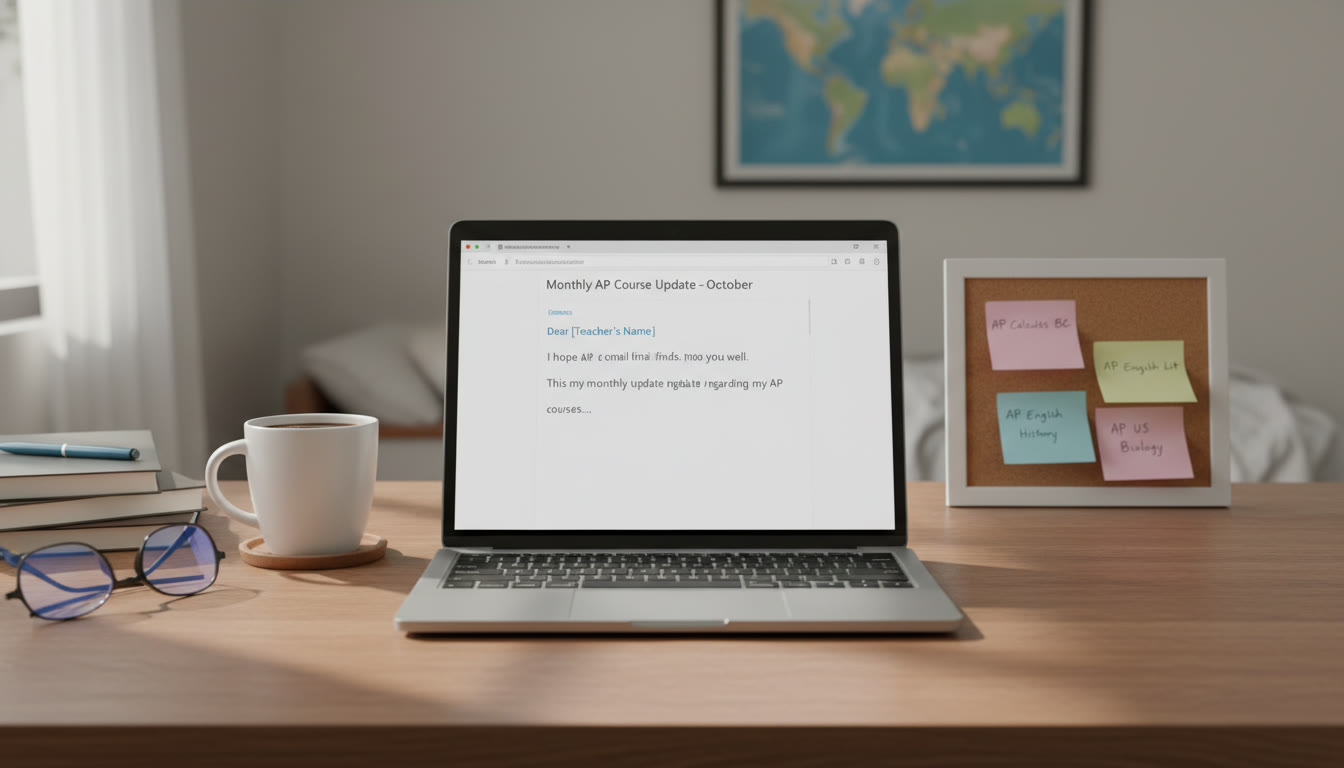Why a Monthly Email Cadence Matters for AP Students
Think of your relationship with your AP teachers like a plant: it grows best with regular, thoughtful care. Not a flood of water one week and total neglect the next, but a steady, predictable routine. For AP students juggling multiple classes, extracurriculars, and college planning, a monthly email cadence—short, regular touchpoints to teachers—can be the difference between feeling overwhelmed and feeling supported.
This is not about spamming your teacher or micromanaging your life. It’s about clarity, accountability, and connection. Done well, monthly emails help you:
- Keep teachers aware of your progress and struggles in a low-pressure way.
- Build a record of communication (useful for recommendations, accommodations, or clarifying grades).
- Signal maturity and initiative—qualities colleges notice and that genuinely help you learn.
- Coordinate feedback loops so your study time is smarter, not just harder.

Who Should Initiate These Emails?
If you are taking an AP class and want to be proactive, you should. Teachers appreciate concise, polite students who ask for help or offer updates—especially in AP classrooms where pacing and college-level expectations can feel intense. If you have a counselor or a tutor (for example, Sparkl’s personalized tutors), coordinate so that your messages are aligned with your broader plan.
Core Principles of a Successful Monthly Touchpoint
Before we get into templates and timing, hold these principles in your back pocket. They keep every message respectful, useful, and easy to reply to.
- Keep it brief: Aim for three short paragraphs. Teachers have 100 other things on their plate.
- Be specific: Name the unit, assignment, or skill you’re talking about.
- Show evidence: Mention a grade, a practice question, or a topic you missed.
- Ask a clear question: If you want feedback, indicate exactly what kind of help you need.
- Offer next steps: Propose a time to meet, or say how you’ll implement the feedback.
- Be appreciative: A brief thank-you goes a long way.
How Often and When: The Timing That Respects Both You and Your Teacher
Monthly is the sweet spot for most students: frequent enough to keep momentum, infrequent enough to be unobtrusive. Here’s a practical rhythm you can adopt:
- 1st week of the month: Quick check-in & goals for the month (30–60 seconds to read).
- Mid-month (optional): If a major assessment occurs, send a 1–2 sentence follow-up summarizing results and next steps.
- End of month (if needed): Reflection on progress and plan adjustment.
Keep in mind school calendars: avoid sending routine check-ins during major exam weeks, school-wide events, or holiday breaks. If your AP teacher prefers a different cadence, adapt—ask them early and honor their preference.
What to Write: Monthly Email Templates You Can Customize
Below are three templates tailored to common student situations: general check-in, after a major exam, and when you need targeted help. Use them as a starting point—make each note your own.
1) Monthly Check-In (General)
Purpose: Share goals, ask a short question, and invite feedback.
- Subject: Monthly Check-In — AP [Course Name] — [Your Name]
- Hi Mr./Ms. [Last Name],
- I hope you’re well. I wanted to share my goals for this month in AP [Course]: I’m focusing on mastering [specific skill or unit], and my target is to improve my topic quiz scores from “X” to “Y.”
- Last week I struggled with [specific problem], and I used [resource] (class notes, AP Daily, practice questions) to review. Do you have one or two suggestions for targeted practice I can complete in 30 minutes a day?
- Thanks for your time and for any pointers. I’ll follow up if I try something new. Best, [Your Name]
2) After a Major Assessment
Purpose: Reflect on performance and request focused feedback.
- Subject: Reflection on [Exam/Assessment Name] — AP [Course] — [Your Name]
- Hi Mr./Ms. [Last Name],
- Thank you for the recent [exam/quiz/essay]. My score was [score/grade], and reviewing my errors, I noticed trouble with [specific concepts or question types].
- Could you recommend one or two practice problems or an approach to help me improve on that area? I can meet during advisory or after school if that’s easier.
- Appreciate your guidance. Best, [Your Name]
3) When You Need Extra Help (Targeted Ask)
Purpose: Ask for clarification, a short meeting, or a resource that targets a specific weakness.
- Subject: Quick Question on [Topic] — AP [Course] — [Your Name]
- Hi Mr./Ms. [Last Name],
- I’m reviewing [topic], and I’m consistently getting stuck on [specific step or concept]. I tried [strategy], but I still don’t feel confident. Do you have a favorite practice question or a short explanation I could use?
- If it helps, I’m free [days/times], and I’d welcome a 10-15 minute chat. Thank you for your time. Sincerely, [Your Name]
Examples: Two Realistic Student Scenarios
Reading examples helps make this workable. Here are two short case studies that show how the cadence strengthens learning over time.
Case Study A: Maya, AP Biology Student
Maya sends a one-paragraph check-in at the start of every month: goals, one question, and availability for office hours. Over three months, her messages help her teacher spot a consistent gap in lab technique and provide a mini-lab session during lunch. Maya’s monthly notes also make it easier for her teacher to write a richly detailed recommendation when she asks for college applications.
Case Study B: Jamal, AP US History Student
Jamal uses his monthly email after each unit test. He includes the three biggest mistakes and asks for a suggested primary source or question set. The teacher replies with two targeted sources and a one-sentence strategy for analyzing documents. Jamal’s essays improve because his study time becomes sharply focused.
How to Organize and Track Your Monthly Emails
A cadence is only useful if you can sustain it. Create a simple tracking system so you don’t forget and so your messages remain coherent.
- Use a calendar reminder on the first Monday of each month titled: “AP Email Check-In”.
- Keep a one-page document or note per class with: last email date, teacher reply highlights, and next month’s goal.
- Save sent messages in a dedicated folder called “AP Touchpoints” so you can reference them when you prepare for meetings or ask for recommendations.
| Element | Purpose | How It Helps |
|---|---|---|
| Monthly Check-In | Set goals and ask one question | Keeps teacher informed; helps shape monthly support |
| Post-Assessment Reflection | Analyze mistakes and request targeted practice | Improves next test performance faster |
| Targeted Help Request | Short meeting or resource request | Addresses specific weakness with minimal time |
Tone and Etiquette: The Human Side of Emails
The single biggest factor in whether a teacher responds helpfully is tone. Use a polite, concise, and respectful voice. A few etiquette tips:
- Address the teacher formally unless they’ve told you to use their first name.
- Be mindful of reply time—teachers often reply within 24-72 hours on school days.
- Never demand regrades or special treatment in the first message; ask for clarification first.
- If your teacher gives a lot of feedback in person, briefly summarize it in your follow-up email to show you were listening.
Sample Friendly Opening Lines
- I hope you had a great weekend—quick question about last week’s lab.
- Thanks for the feedback on my essay; following up with a couple of clarifying questions.
- I’m setting a monthly goal for AP Chemistry and wanted to share it with you and get one quick resource.
When the Monthly Cadence Should Shift
Monthly emails are a guideline, not a law. Certain moments call for a change in pace:
- Bump up to biweekly: During intense review months (e.g., two months before AP exams) or if you’re working on a major project.
- Pull back: If the teacher asks you to limit emails, or if you’ve established a weekly in-person check-in.
- Switch to different channels: Some teachers prefer quick messages through class platforms (AP Classroom, school LMS) for clarifications—use those when appropriate.
How Tutors and Personalized Support Fit In
Monthly emails to teachers do not replace tutoring; they complement it. If you work with a personalized tutor—like Sparkl—your touchpoints become even more powerful. Here’s how they can work together:
- Your tutor can help you draft concise emails that hit the right tone and clarity.
- After reviewing teacher feedback, tutors help translate suggestions into actionable study plans and practice sets.
- AI-driven insights and diagnostics from personalized tutoring platforms can identify the exact skills you should mention in your monthly check-in, making your ask more precise and efficient.
In short: teachers guide, tutors amplify. When both are on the same page, your study time becomes more strategic and less scattershot.
Logistics Table: How Teachers and Tutors Can Share the Load
| Role | What They Provide | How You Use Monthly Emails |
|---|---|---|
| Teacher | Curriculum guidance, feedback on assignments, exam scoring | Inform them of goals and ask for targeted practice or clarification |
| Tutor (e.g., Sparkl) | 1-on-1 guidance, tailored study plans, practice strategies, AI insights | Use teacher feedback to refine tutor-led practice and timing |
Measuring Success: How to Know the Cadence Is Working
Metrics don’t have to be fancy. Use these simple indicators to measure whether your monthly touchpoints are helping:
- Are your quiz and test errors shrinking on the topics you ask about?
- Does your teacher respond with actionable feedback or resources?
- Do you feel more confident entering labs, essays, or problem sets?
- Is your study time more focused (e.g., 30 minutes of targeted practice vs. two unfocused hours)?
If the answer is “yes” to most of these, you’re onto something. If not, tweak your template: be more specific, show the work you tried, and offer a proposed time to meet.
Common Pitfalls and How to Avoid Them
Students often make a few recurring mistakes when building a communication cadence. Here’s how to sidestep them:
- Pitfall: Sending long, rambling emails. Fix: Use bullet points and a one-line subject that summarizes the ask.
- Pitfall: Sending messages during peak teacher stress weeks (exam season). Fix: Check the school calendar and time your message when it’s likely to be read.
- Pitfall: Expecting instant responses. Fix: Allow 48-72 hours on school days; if time-sensitive, ask in person or arrange prior.
Putting It All Together: A 90-Day Plan
Here’s a compact plan to test a monthly cadence and refine it using feedback and outcomes.
- Month 1: Send a baseline check-in, set one measurable goal, and ask for one resource. Track replies and any suggested next steps.
- Month 2: After any unit test, send a reflection with three specific mistakes and request one targeted practice item. If you work with a tutor, share the teacher’s feedback and have them build a 2-week practice plan.
- Month 3: Send a progress update comparing your Month 1 baseline to current performance and propose next steps (e.g., extra review sessions, adjusted goals).
At the end of 90 days, you should have a clearer picture of the cadence’s value and whether to increase, maintain, or reduce contact frequency.
Final Thoughts: Keep It Human
Teachers want to support motivated students. A monthly email cadence communicates you care about learning—not just grades—and that you respect their time. Combine those emails with smart study habits, targeted practice, and, when needed, personalized tutoring (Sparkl’s 1-on-1 guidance and tailored plans can be especially useful here) and you’ll create a powerful feedback loop.
Start small, keep it consistent, and be kind—both to your teachers and to yourself. Over time, these small, regular touchpoints add up into better understanding, better grades, and a much less stressful AP experience.

Quick Reference: Monthly Email Checklist
- Subject line: Course and short descriptor.
- One-line greeting.
- One-sentence summary of goal or result.
- One specific question or request.
- One proposed next step (meeting time or practice plan).
- One sentence of thanks.
Ready to try it? Draft your first monthly check-in tonight. Keep it under five sentences, and remember: clarity is your superpower. If you’d like help drafting a personalized message or turning teacher feedback into a two-week study plan, consider working with a tutor who can create an efficient, evidence-based approach tailored to your needs. Small, consistent habits—like a monthly email—compound into big wins by test day.
Closing
Maintaining an intentional, monthly email cadence with your AP teachers is a practical, low-effort habit that pays back in clarity, connection, and improved results. Treat communication as another study skill: plan it, practice it, and refine it. Your teachers will notice—and so will you.




















No Comments
Leave a comment Cancel